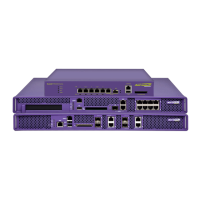Summit WM3000 Series Controller System Reference Guide 95
2 Refer to following details within the table:
For an adopted AP to work properly with Summit WM3700 you need to have independent and extended WLANs
mapped to a different VLAN than the ge port.
3 Select a record from the table and click the Edit button to modify the record. For more information,
see “Editing the Details of an Existing VLAN by Port” on page 95.
Editing the Details of an Existing VLAN by Port
To revise the configuration of an existing VLAN:
1 Select Network > Virtual LANs from the main menu tree.
2 Select an Ethernet for which you want to configure the VLAN and click on the Edit button.
The system prompts you with a Port VLAN Change Warning message stating communication
disruptions could occur with the controller.
3 Click OK to continue.
Name
Displays the name of the VLAN to which the controller is currently
connected.
Mode
It can be either Access or Trunk.
•
Access
– This ethernet interface accepts packets only from the native
VLANs.
•
Trunk
– The Ethernet interface allows packets from the given list of
VLANs you add to the trunk.
Native VLAN
Displays the tag assigned to the native VLAN.
Allowed VLANs
Displays VLAN tags allowed on this interface
Native VLAN Tagged
Displays if the Native VLAN for each port is tagged or not. The column
displays a green check mark if the Native VLAN is tagged. If the Native
VLAN is not tagged the column will display a red “x”.
A Native VLAN is the VLAN which untagged traffic will be directed over
when using a port in trunk mode.

